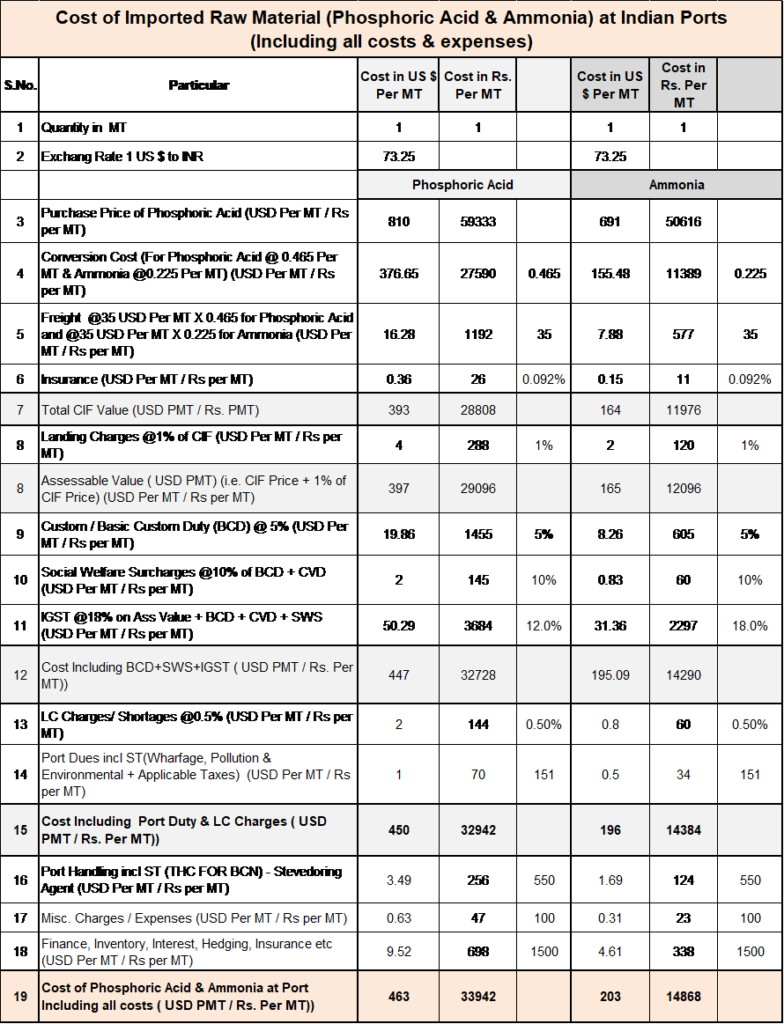The imported DAP prices are increasing globally. Not only DAP, its raw material prices for both phosphoric acid and ammonia, are also increasing. Looking at the international price of DAP at the US $ 543.40 per MT, It seems to be unviable to make available imported DAP to the farmers in India, at an affordable price, unless subsidy rates changes. The importer will make a loss, if DAP MRP is below the US $ 580 per MT (Rs.42.5 K per MT), then what is the alternate?
In the last article of “Is import of DAP viable in India”, MRP of DAP is calculated at the US $ 580 per MT, after subsidy, if the international price of DAP is US $ 543.40 per MT.
Is DAP production with the imported raw material of phosphoric acid and ammonia, viable in comparison to the import of DAP in India?
Will production of indigenous DAP in India is a better option in place of import, to supply / to ensure availability of DAP to the Indian farmers at an affordable price?
If so, India should think about the indigenous production of DAP but if we see the history, DAP capacities were not fully utilized, Why?
In the current situation, a hike in the international price of DAP and its raw material phosphoric acid and ammonia, ongoing Kharif season, together with the anticipation of normal monsoon rain as well as low opening stock levels for Kharif, is a matter of concern for India, not only for ongoing Kharif but also for incoming Rabi season.
Should India reserve a substantial quantity of imported DAP or its raw material, at increased prices to ensure availability in the incoming Rabi season?
The converted cost for 0.465 MT of imported phosphoric acid, including all costs at Indian port with customs duty, IGST, Port Duty and LC Charges, etc., is around US$ 450 per MT ( Rs.32942 per MT), at a current international price of phosphoric acid @810 USD per MT.
The current international price of ammonia is around the US $ 691 per MT. The converted cost for 0.225 MT of ammonia including all costs (Custom duty, IGST, Port Duty & Other Costs, etc.), at Indian port is around the US $ 196 per MT (Rs.14383 per MT).
Other costs for conversion, stevedoring agents/port handling charges, finance, Inventory, Interest, Hedging, Insurance, etc. are around the US $ 13 per MT for phosphoric acid and the US $ 7 per MT for ammonia.
The conversion cost from raw material to finished product DAP and distribution margin add around the US $ 85 per MT, to the total cost. As per existing rate of subsidy on DAP in India according to the NBS scheme is US $ 160 per MT at this stage.
This calculation does not include the impact of GST refund which follows the inverted tax structure as per the GST scheme. The refund is calculated by the company @18% GST paid on raw materials, conversion costs, port charges, etc., less the GST payable on the finished DAP @5%, at the cost per MT of DAP after excluding the subsidy.
For imported DAP, the MRP @ 580 US $ per MT plus GST, after subsidy outgo of US $ 160 per MT, is calculated at the current international DAP price of US $ 543.40 per MT.
If DAP is produced in India, from imported raw material (Phosphoric Acid & Ammonia), the MRP of indigenous DAP is calculated @ 606 US $ per MT plus GST, after subsidy outgo of US $ 160 per MT, at the current international price of Phosphoric Acid at the US $ 810 per MT and Ammonia at the US $ 691 per MT, as per below table.

